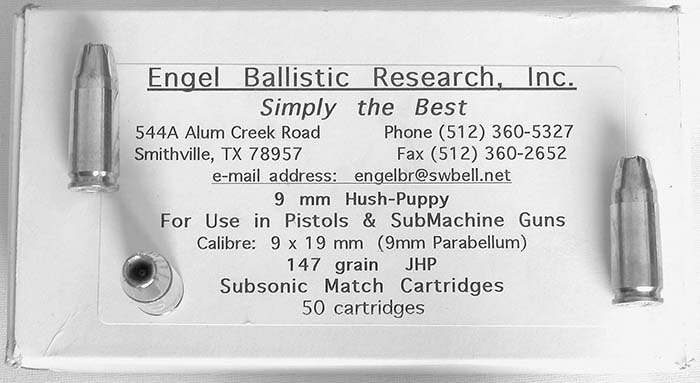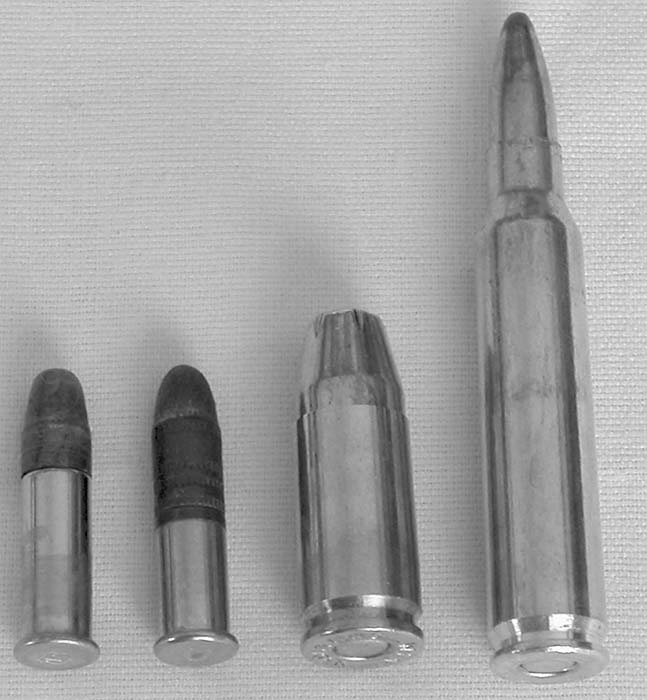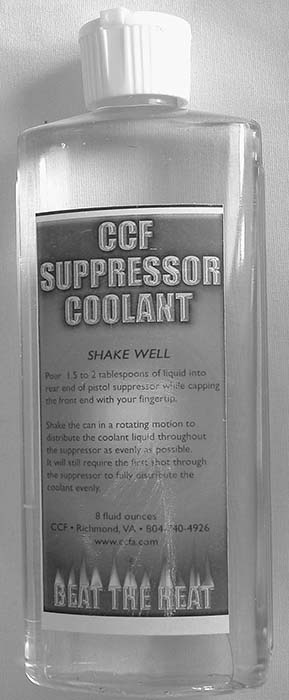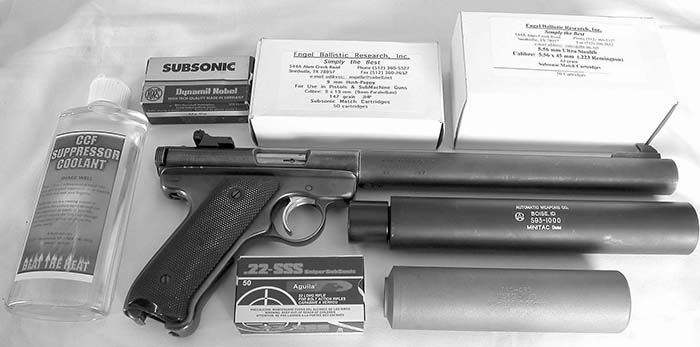A small selection of sound suppressors, subsonic ammunition and coolant.
By Jeff W. Zimba
Sound suppressors generally fall into three categories. There are those that use wipes, those that use just baffles with no wipes, and those that are referred to as artificial environmental or “wet” cans. There are several more distinctions in each category but those are the basic three. While there are indeed several designs, sizes, shapes and types of sound suppressors, they generally all work on the same principals.
Contrary to popular misconception, smokeless powder does not explode, creating the noise you hear when shooting a rifle or pistol. The majority of the extremely loud noise created when shooting a firearm comes from the massive expansion and fast escape of hot gasses. This gas expands extremely fast when it burns, and creates an enormous amount of pressure. It is this pressure that builds and pushes the projectile from the barrel and most of the loud “explosion” you hear is this gas and pressure escaping at such a rapid rate. A sound suppressor slows this process and bleeds these residual gasses at a much slower rate, therefore greatly reducing the sound.
If you think of the function of a sound suppressor along the same lines as the role of an automotive exhaust system, its task is a little easier to understand. If you listen to a vehicle run with no muffler, such as a drag racer or stock car, the noise is quite excessive. If you compare that noise to the sound of your car or truck with a functioning exhaust system and muffler, although your vehicle is not “silent” the reduction in sound is evident. Another analogy to help illustrate the function of the sound suppressor is the common party balloon. Take two equally filled balloons, having the same pressure and volume in each. If you take a pin and release the pressure all at once in the first one, and then just untie the stem and slowly release the pressure in the second one, you will see a huge difference in the sound. Some suppressors work with this principal, slowly bleeding the pressure over a longer time.

The second loudest noise associated with shooting happens when the bullet creates a sonic boom. A sonic boom is a shock wave formed when the projectile travels faster than the speed of sound. The speed of sound at sea level is approximately 1115 feet per second, (750 miles per hour). This is also affected by air temperature, humidity and other atmospheric considerations. While 1115 fps is the speed of sound at 58ºF, it can vary from around 1050 fps at 0ºF to 1160 fps at 100ºF. By using special subsonic ammunition this portion of the noise can easily be alleviated.
The type and design of the suppressor will greatly affect the performance in the amount of sound suppression and some are indeed significant in their sound reduction. Even using subsonic ammunition, there is nothing quite as effective as those “Hollywood silencers” in the movies, and their incredibly unrealistic low signature.
In the first category of those that use wipes, the expansion chambers and other interior features tend to vary but the common factor is the use of a pliable material that the bullet must travel through before exiting the suppressor. It is this material that the bullet passes through that is commonly referred to as the “wipe”. This design is very effective in reducing the sound signature. When the bullet passes through the wipe, the pliable material is momentarily expanded to accommodate the projectile and then immediately contracts back to its previous shape slowing the escape of the hot gasses and therefore reducing the sound. The drawbacks are the necessity to frequently replace the “wipe” material and the loss in accuracy from the projectile actually touching the material upon exiting the suppressor.
In the second category of those sound suppressors that are “wipeless”, the interior baffle and expansion chamber designs vary greatly by manufacturer, but the thing they all have in common is the lack of any “wipe” material. A common design for a wipeless sound suppressor may include an expansion chamber immediately beyond the muzzle, followed with a series of baffles before the end cap. The expansion chamber is where the bulk of the gasses gather immediately following firing. The baffles could be of several designs but are generally a series of circular discs with a hole in their center allowing the bullet to pass through while holding the gasses behind. After the bullet passes through the section of baffles and exits the sound suppressor, the expanding, hot gasses can then pass through this section cooling and slowing as it exits. This creates the reduction in noise. There are two immediate advantages of these wipeless suppressor designs over those that utilize wipes. First, there is no wipe material to erode that has to be often replaced. Secondly, there is nothing actually coming in contact with the bullet, therefore increasing accuracy over the latter design. Some may argue that these are not as quiet as those that utilized wipes but many users seem to prefer this style of sound suppressor.
The third category of sound suppressor is the artificial environmental or “wet” suppressor. These suppressors use internals very similar (and sometimes identical) to the wipeless suppressors. These designs allow the use of water or other medium to be utilized inside the suppressor system. When a liquid or other wet medium is introduced to the inside of the sound suppressor it causes the gasses to be cooled much faster by transferring the heat into the liquid. The actual phase change of the artificial medium also greatly affects the sound suppression. When the heat transfers its energy to the medium, and the medium is converted into a liquid from a solid or to a steam from a liquid, this phase change equates to even less sound. This particular type of sound suppressor design has been around for a number of years. The effectiveness of this heat transfer to the liquid medium allows a suppressor to be quite small and still remain very effective. When a liquid medium is used in a standard sized suppressor its performance is even more apparent. The advantage of this type of suppressor is obviously the additional reduction in sound. The disadvantages are the necessity to “recharge” the suppressor to maintain its effectiveness after a number of rounds have been fired, and the “transfer” of the liquid medium to the host firearm, the shooter and/or the surrounding area. The particular liquid medium used will determine the severity of the last mentioned disadvantage.

With water possibly being the most common medium to use in a wet can, the author has heard of several other, extremely creative liquids being utilized. You have to keep in mind that anything you use as a wet medium will probably come in contact with you and your firearm. Grease is a popular medium but the operator must be certain that there is no blockage to restrict the bullet. A suppressor that has been heavily charged with grease might find some heavy depositing in the firearm and around the surrounding area as well. If you are using water, there is little smell to be concerned with although the water migrating out of the suppressor during firing can still leave a mess on your firearm and clothing. (It is important to lubricate the firearm very well when introducing water to any metal components.) During the testing of the CCF Suppressor Coolant(tm) we noticed it resisted this splattering and there was very little mess at all compared to other types of coolants, following the firing.
The extreme transfer of heat will cause the chosen medium to eventually burn or evaporate and there are certain smells that will be associated with the medium you use. I know some users who utilize shaving cream as a medium and have had other shooters at the range comment on the pleasant smell coming from their shooting position. Some other wet mediums the author is aware of people using include, but are not limited to KY-Jelly, toothpaste, Ultrasound Gel, Diet Soda and Break-Free. I cannot endorse any of these mediums as they are not personally used by me, but I did stumble on to something new recently that seems to work pretty well. It is called CCF Suppressor Coolant(tm) and was just introduced by Capital City Firearms of Richmond, Virginia. It is a clear liquid and is supplied in 8 ounce, flip-top bottles. It is a single-synthetic polymer with extreme heat and pressure resistance qualities. CCF indicates the coolant has a greater thermal conductive rate than water and zero toxicity. It is this higher thermal conductive rate that gives their coolant the suppression efficiency advantage over water by as much as 3 – 4db.
When water is used as a medium it usually lasts a dozen shots or so before it needs a recharge. This is typically due to seepage and evaporation from the heat exposure. The migration out of the can from the gas pressure under fire, and its transition to steam are also factors. One of the properties of the CCFA Suppressor Coolant(tm) is that it is not affected by evaporation so the suppressor coolant can last 70 – 90 shots before needing a recharge. It can also be charged months before the intended use with no loss of performance.
Since this coolant doesn’t burn there is no smoke to act as a position marker, something that may be important to the tactical user. To the recreational user it just means not having to inhale clouds of smoke at the range.
As an extra positive point, the CCF Suppressor Coolant(tm) has physical properties that stop the buildup of carbon on the internals of the suppressor components. This means effortless cleanup instead of having to soak carbon-encrusted parts for days to break it up.

Well, these are all claims by Capital City Firearms and a few of them seem a little too good to be true so they sent me a bottle to test for myself. For starters, I charged the suppressor, a 9mm Carbon Fiber Impulse IIA a week before going out to the range. I had actually intended to get out a little sooner but it ended up being over 5 days before the weather and my schedule were able to work together. It was attached to a 9x19mm HK USP SD and the magazine was loaded. The slide was racked and the first round was launched downrange. This was extremely quiet. Before I knew it, we ran an entire box of ammo through it. It was passed all around the range and everyone had the same confused look when passing it back to me. “I thought you said that was a wet can, when are you going charge it?” I was asked after 20 or so rounds. I explained that I already charged it before I left for the range. After we ran the second box of ammo through it, it slowly started to get a little louder. It was time for a recharge. When I pulled out the bottle with the flip-top and poured about 2 tablespoons into the rear of the suppressor I few people lined up saying, “let me look at that”. The first thing they would do was smell the liquid but it really has no smell. A few more magazines were loaded up and the shooting began again. After handling the USP when the third magazine was emptied again the first comment I got was “where is the mess?” Some additional conversing followed and everyone agreed that there was no noticeable smoke, even after firing almost 150 rounds at that point. After finishing the last box of ammo, everything was packed up and the range day was over. We all left pleasantly surprised. The only thing that was not mentioned was there is a scent of lemon in the air after firing. It is not extremely strong and certainly not overbearing but it is noticeable.
Summary: All the claims made by Capital City Firearms about their CCF Suppressor Coolant(tm) to me rang true. It held the charge for an extended period of time and took over a full box of ammo to start getting louder to the ear. There was no smoke and not a significant amount of “splatter”. There are no special tools necessary to charge the suppressor. Being short on time I never had the chance to disassemble the suppressor to check the clean-up but I did reach in with a cotton swab and everything I could reach just wiped off like it had been coated with Teflon(r). At $21.95 for an 8 ounce bottle and no applicator necessary, it appears to be money well spent.
Sources
Capital City Firearms
CCF Suppressor Coolant(tm)
Dept. SAR
Richmond, VA
804-740-4926
www.ccfa.com
Engel Ballistic Research, Inc.
Subsonic Ammunition
Dept. SAR
544 Alum Creek Road
Smithville, TX 78957
512-360-5327
www.ebr-inc.net
| This article first appeared in Small Arms Review V7N11 (August 2004) |










